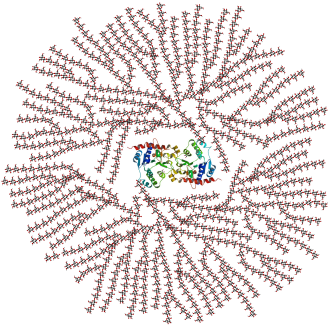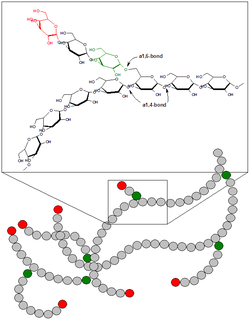Polysaccharide
A polysaccharide is[1] a complex carbohydrate. Polysaccharides are polymers made up of many monosaccharides. They are very large, often branched, molecules. They tend to be amorphous, insoluble in water, and have no sweet taste.
When all the constituent monosaccharides are of the same type they are termed homopolysaccharides; when more than one type of monosaccharide is present they are termed heteropolysaccharides.
Examples of polysaccharides include storage polysaccharides such as starch and glycogen and structural polysaccharides such as cellulose and chitin.
Schematic 2-D cross-sectional view of glycogen. A core protein of glycogenin is surrounded by branches of glucose units. The entire globular granule may contain approximately 30,000 glucose units.[2]
Starches
Starches are insoluble in water. They can be digested by hydrolysis, catalyzed by enzymes called amylases. Humans and other animals have amylases, so they can digest starches. Potato, rice, wheat, and maize are major sources of starch in the human diet.
Cellulose
The structural components of plants are formed primarily from cellulose. Wood is largely cellulose and lignin, while paper and cotton are nearly pure cellulose. Cellulose is a polymer made with repeated glucose units. Humans and many other animals do not digest cellulose. Certain animals can digest cellulose, because bacteria possessing the enzyme are present in their gut. The classic example is the termite.
Polysaccharide Media
3D structure of cellulose, a beta-glucan polysaccharide
Amylose is a linear polymer of glucose mainly linked with α(1→4) bonds. It can be made of several thousands of glucose units. It is one of the two components of starch, the other being amylopectin.
References
- ↑ "Chapter 3: Carbohydrates/glycans". employees.csbsju.edu. Retrieved 2024-05-26.
- ↑ McArdle WD, Katch FI, Katch VL (2006). Exercise physiology: energy, nutrition, and human performance (6th ed.). Lippincott Williams & Wilkins. p. 12. ISBN 978-0-7817-4990-9.





